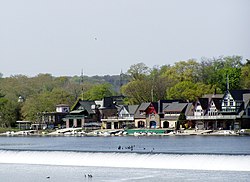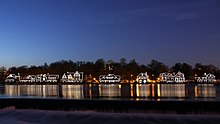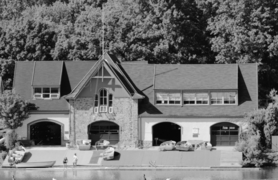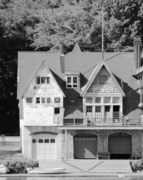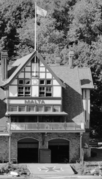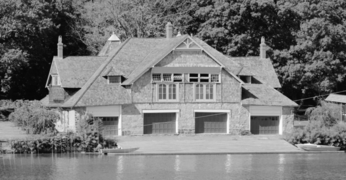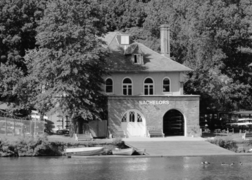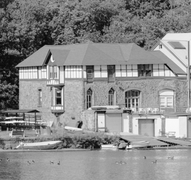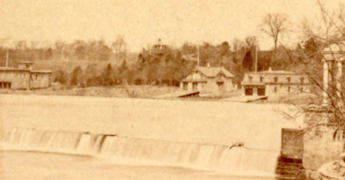
Fairmount Park is the largest municipal park in Philadelphia and the historic name for a group of parks located throughout the city. Fairmount Park consists of two park sections named East Park and West Park, divided by the Schuylkill River, with the two sections together totalling 2,052 acres (830 ha). Management of Fairmount Park and the entire citywide park system is overseen by Philadelphia Parks & Recreation, a city department created in 2010 from the merger of the Fairmount Park Commission and the Department of Recreation.
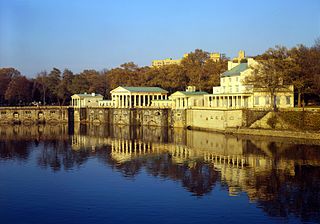
The Fairmount Water Works in Philadelphia, Pennsylvania, was Philadelphia's second municipal waterworks. Designed in 1812 by Frederick Graff and built between 1812 and 1872, it operated until 1909, winning praise for its design and becoming a popular tourist attraction. It now houses a restaurant and an interpretive center that explains the waterworks' purpose and local watershed history. It was designated a National Historic Landmark in 1976 for its architecture and its engineering innovations. It was the nation's first water supply to use paddle wheels to move water.
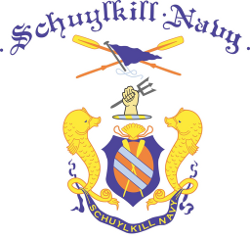
The Schuylkill Navy is an association of amateur rowing clubs of Philadelphia. Founded in 1858, it is the oldest amateur athletic governing body in the United States. The member clubs are all on the Schuylkill River where it flows through Fairmount Park in Philadelphia, mostly on the historic Boathouse Row.

The Lighthouse on Turtle Rock is a lighthouse built in 1887 to aid traffic on the Schuylkill River near Philadelphia, Pennsylvania. The lighthouse was constructed by Frank Thurwanger at a cost of $2,663 on an area of land just west of Boathouse Row. The lighthouse has a hexagonal lantern room with an octagonal walkway. Gas was first used to power the light, but in 1990, when the lighthouse was repainted and received a new wooden balustrade and newel posts, the beacon was electrified.

Bachelors Barge Club is an amateur rowing club located at #6 Boathouse Row in the historic Boathouse Row of Philadelphia, Pennsylvania. It is the oldest continuously operating boathouse in the United States. It went through renovations as part of the "Light Boathouse Row" initiative, in which new LED lights were fitted to each of the boathouses. Bachelors Barge Club is currently home to several programs, including the Conestoga High School Crew Team, and the Drexel University Crew Team, among several others.

Lemon Hill is a Federal-style mansion in Fairmount Park, Philadelphia, built from 1799 to 1800 by Philadelphia merchant Henry Pratt. The house is named after the citrus fruits that Pratt cultivated on the property in the early 19th century.

Fairmount Rowing Association is an amateur rowing club, founded in 1877. The facility, located at #2 Boathouse Row in the historic Boathouse Row of Philadelphia, Pennsylvania, is on the National Register of Historic Places. Fairmount originally catered to blue-collar youths living in the Fairmount neighborhood. In 1916, after decades of being rejected, the club was finally allowed to join the Schuylkill Navy. The Club boasts being known as the "premiere club for Masters rowing in the mid-Atlantic region" and has produced several world class rowers.
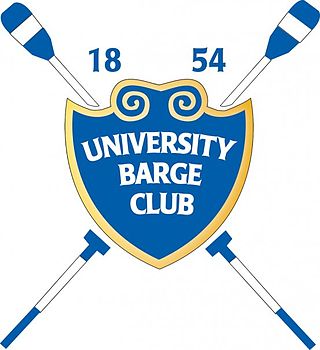
University Barge Club of Philadelphia is an amateur rowing club located at #7 in the historic Boathouse Row of Philadelphia, Pennsylvania. It is listed on the National Register of Historic Places and designated a National Historic Landmark. The club's founding, in 1854, is considered the "dawn of organized athletics in the University of Pennsylvania." Known as "the upper-class rowing club," UBC is a founder, and the most senior member, of the oldest amateur athletic governing body in the United States, the Schuylkill Navy.

Pennsylvania Barge Club is an amateur rowing club, situated along the historic Boathouse Row of Philadelphia, Pennsylvania. It was founded in 1861 and joined the Schuylkill Navy in 1865. The club's boathouse, at #4 Boathouse Row, is also known as the Hollenback House, named for William M. Hollenback, Jr., who served as President of USRowing from 1979 until 1985.

Crescent Boat Club is an American amateur rowing club located at #5 Boathouse Row in the historic Boathouse Row of Philadelphia, Pennsylvania. It was founded in 1867 when Pickwick Barge Club and Iona Barge Club merged. Crescent Boat Club joined the Schuylkill Navy in 1868. In 1871, Crescent competed in and won the doubles event in the first regatta of the National Association of Amateur Oarsmen, an event "which undoubtedly helped the sport greatly."

Penn Athletic Club Rowing Association is an amateur rowing club located at #12 Boathouse Row in the historic Boathouse Row of Philadelphia, Pennsylvania. Penn AC was founded in 1871 as the West Philadelphia Boat Club. Penn AC has been a destination for elite rowers looking to make the US National Team, ever since John B. Kelly Sr. joined Penn AC after a schism with his former club, Vesper.
The Vesper Boat Club is an amateur rowing club located at #10 Boathouse Row in the historic Boathouse Row of Philadelphia, Pennsylvania. Founded in 1865 as the Washington Barge Club, the club's name was changed to Vesper Boat Club in 1870.

Malta Boat Club is an amateur rowing club located at #9 Boathouse Row in the historic Boathouse Row of Philadelphia, Pennsylvania. In 1865, the Club joined the Schuylkill Navy when it relocated to the Schuylkill River from the Delaware River and purchased the facilities of the now defunct Excelsior Club. While on the Delaware, the club occupied a house on Smith’s Island where the club stored its boat called the "Minnehaha". The club was founded by members of the Minnehaha Lodge of the Sons of Malta. The Sons of Malta, originally organized in the South, did not survive the Civil War.

Undine Barge Club is an amateur rowing club located at #13 Boathouse Row in the historic Boathouse Row along the Schuylkill River in Philadelphia, Pennsylvania. The club was founded in 1856. Undine was not initially listed as a founder of the Schuylkill Navy, but is now considered a founder because an Undine member, Mr. B. F. Van dyke, was elected to represent the club as secretary treasurer of the Navy from its birth in 1858. In 1860, Undine purchased Keystone Barge Club's boat and equipment, as Keystone had disposed of its boathouse.
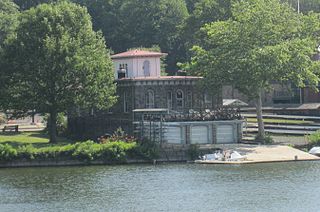
Philadelphia Girls' Rowing Club is an amateur rowing club located at #14 Boathouse Row in the historic Boathouse Row along the Schuylkill River in Philadelphia, Pennsylvania. It is the oldest all-female rowing club in existence. Built in 1860, the club's boathouse is the oldest structure on Boathouse Row, which is listed on the National Register of Historic Places and designated a National Historic Landmark.

The College Boat Club of the University of Pennsylvania is the rowing program for University of Pennsylvania Rowing, which is located in the Burk-Bergman Boathouse at #11 Boathouse Row on the historic Boathouse Row of Philadelphia, Pennsylvania. Its membership consists entirely of past and present rowers of the University of Pennsylvania.
Gillin Boat Club is the rowing program for St. Joseph's University Rowing and St. Joseph's Prep Rowing. It is situated at the 1,000-meter mark of the Schuylkill River race course in Fairmount Park, Philadelphia, Pennsylvania. Gillin Boat Club was admitted to the Schuylkill Navy in 2004, by a unanimous vote of the Navy's members.

The Thomas Eakins Head of the Schuylkill Regatta is a rowing race held annually during the last weekend in October on the Schuylkill River in Philadelphia, Pennsylvania. The HOSR is the final race in the Fall Fury series, which includes the Head of the Ohio and the Head of the Connecticut. Along with the Head of the Charles and the Head of the Connecticut, the HOSR is considered one of the three “fall classics.” The HOSR is one of the marquee races in the Philadelphia Classic Regatta Series, which also includes the Stotesbury Cup Regatta, the Philadelphia Scholastic Rowing Championship, the Schuylkill Navy Regatta, and the Independence Day Regatta.
Regattas such as the Head of the Charles in Boston and the Head of the Schuylkill in Philadelphia are to the rowing world what the New York Marathon and the Boston Marathon are to running.

The Lilacs is an early 18th-century farmhouse located in northwestern Fairmount Park, Philadelphia. The house has a large addition constructed in the early 19th century. The name was derived from the many lilac bushes on the property.
